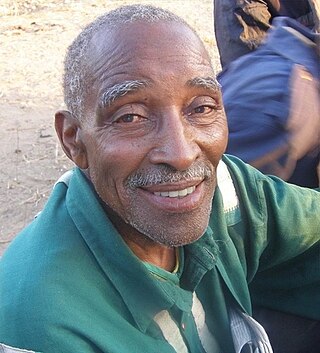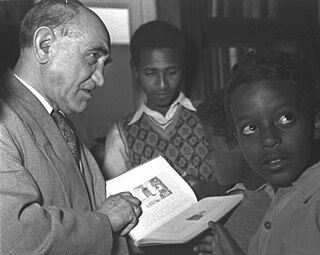Related Research Articles

The Ark of the Covenant, also known as the Ark of the Testimony or the Ark of God, is a legendary artifact believed to be the most sacred relic of the Israelites, which is described as a wooden chest, covered in pure gold, with an elaborately designed lid called the mercy seat. According to the Book of Exodus, the Ark contained the two stone tablets of the Ten Commandments. According to the New Testament Book of Hebrews, it also contained Aaron's rod and a pot of manna.

The Sena, Lemba, Remba, or Mwenye are an ethnic group which is native to South Africa, Malawi, Mozambique and Zimbabwe of mixed Bantu and Yemeni heritage. Within South Africa, they are particularly concentrated in the Limpopo province and the Mpumalanga province.

The Bene Israel, also referred to as the "Shanivar Teli" or "Native Jew" caste, are a community of Jews in India. It has been suggested that they are the descendants of one of the Ten Lost Tribes via their ancestors who had settled there centuries ago. In the 19th century, after they were taught about normative Judaism, they migrated from villages in the Konkan region to nearby cities throughout British India—primarily to Mumbai, but also to Pune, Ahmedabad, and Karachi, where they gained prominent positions within the British colonial government and the Indian Army.

African Jewish communities include:

The Beta Israel, also known as Ethiopian Jews, are a Jewish community that lived for centuries in the area of the Kingdom of Aksum and the Ethiopian Empire, which is currently divided between the modern-day Amhara and Tigray regions of Ethiopia. Most of the Beta Israel community immigrated to Israel in the late 20th century.
African-American Jews are people who are both African American and Jewish. African-American Jews may be either Jewish from birth or converts to Judaism. Many African-American Jews are of mixed heritage, having both non-Jewish African-American and non-Black Jewish ancestors. Many African-American Jews identify as Jews of color, but some do not. Black Jews from Africa, such as the Beta Israel from Ethiopia, may or may not identify as African-American Jews.

Falash Mura is the name given to descendants of the Beta Israel community in Ethiopia who converted to Christianity, primarily as a consequence of Western proselytization during the late 19th and early 20th centuries. This term also includes Beta Israel who did not adhere to any Ethiopian Jewish practices, as well as the aforementioned historical converts to Christianity. While most voluntarily converted, some were also forcibly converted against their will, or felt compelled to convert due to economic hardship and social exclusion in a majority Christian population.
The Bene EphraimBnei Ephraim, also called Telugu Jews because they speak Telugu, are a small community living primarily in Kotha Reddy Palem, a village outside Chebrolu, Guntur District, and in Machilipatnam, Krishna District, Andhra Pradesh, India, near the delta of the River Krishna. They claim to be descendants of the Tribe of Ephraim, of the Ten Lost Tribes, and since the 1980s have learned to practice modern Judaism.
Black Hebrew Israelites are a new religious movement claiming that African Americans are descendants of the ancient Israelites. Some sub-groups believe that Native and Latin Americans are descendants of the Israelites as well. Black Hebrew Israelites combine elements to their teaching from a wide range of sources to varying degrees. Black Hebrew Israelites incorporate certain aspects of the religious beliefs and practices of both Christianity and Judaism, though they have created their own interpretation of the Bible, and other influences include Freemasonry and New Thought, for example. Many choose to identify as Hebrew Israelites or Black Hebrews rather than Jews in order to indicate their claimed historic connections.
The history of the Jews in South Africa began during the period of Portuguese exploration in the early modern era, though a permanent presence was not established until the beginning of Dutch colonisation in the region. During the period of British colonial rule in the 19th century, the Jewish South African community expanded greatly, in part thanks to encouragement from Britain. From 1880 to 1914, the Jewish population in South Africa grew from 4,000 to over 40,000. South African Jews have played an important role in promoting diplomatic and military relations between Israel and South Africa. South Africa's Jewish community has reportedly declined from a possible peak of 120,000 to now between 52,000 and 88,000. Many South African Jews have emigrated to countries in the English-speaking world, such as the United States, Canada, the United Kingdom and Australia, as well as some emigrating to Israel.
Several groups claim they descend from the ancient Israelites. The issue has been especially relevant since the establishment of the State of Israel and an individual or a group's request to immigrate to Israel under its Law of Return. In that context, claims of affiliation with the Israelites give rise to questions of "who is a Jew?" Some of these claims have been recognized, while other claims are still under review and other claims have been rejected.
Steven Kaplan is a professor of African studies and comparative religion at Hebrew University in Jerusalem. He is one of the leading modern scholars on the origins of the Beta Israel, or Ethiopian Jews. He was the Dean of the Faculty of Humanities at Hebrew University from 2004-2006.

The Ten Lost Tribes were the ten of the Twelve Tribes of Israel that were said to have been exiled from the Kingdom of Israel after its conquest by the Neo-Assyrian Empire c. 722 BCE. These are the tribes of Reuben, Simeon, Dan, Naphtali, Gad, Asher, Issachar, Zebulun, Manasseh, and Ephraim; all but Judah and Benjamin. However, since the tribe of Simeon lived well within the territory of Judah, it is not clear why this tribe was never included in this list. Also, the tribes of Asher and Reuben were never mentioned as participating in anything after the conquest, living in either Phoenician (Asher) or Moabite (Reuben) controlled territory. By the middle 9th century BCE the territory of Gad was also (re)taken by the Moabites, so the Assyrians could at most have removed the other six tribes. Thus, the "10 tribes" appears to be a misnomer, meaning all of the Israelites that were living outside the Kingdom of Judah. The Jewish historian Josephus wrote that "there are but two tribes in Asia and Europe subject to the Romans, while the ten tribes are beyond Euphrates till now, and are an immense multitude, and not to be estimated by numbers".
Beta Abraham —other terms by which the community have been known include Tebiban, Balla Ejj, Buda and Kayla ,—is a community regarded by some as a crypto-Jewish offshoot of the Beta Israel community. The size of the community is estimated to be somewhere upwards of 150,000 in number.

Jacques Faitlovitch (1881–1955) was an anthropologist.

The history of the Jews in Zimbabwe reaches back over one century. Present-day Zimbabwe was formerly known as Southern Rhodesia and later as Rhodesia.
Edith Bruder is a French ethnologist who has specialized in the study of African Judaism and religious diasporas, new religious movements, and marginal religious societies. She is a research associate at the School of Oriental and African Studies (SOAS), University of London; a research associate at the French National Center for Scientific Research (CNRS); and a research fellow at the Faculty of Theology's School of Biblical Studies and Ancient Languages, North-West University, South Africa.
Shalva Weil is a senior researcher at The Seymour Fox School of Education at the Hebrew University of Jerusalem, Israel. In 2017, she was GIAN Distinguished Professor at Jawaharlal Nehru University, in New Delhi. She has researched Indian Jews, Ethiopian Jews, and the Ten Lost Tribes and specializes in femicide, qualitative methods, violence, ethnicity, education, religion, and migration.
Black Judaism is Judaism that is practiced by communities of African descent, both in Africa and in the African diaspora, including in North America, Europe, Israel, and elsewhere. Significant examples of Black Judaism include Judaism as it is practiced by Ethiopian Jews and African-American Jews. Jews who may be considered Black have existed for millennia, with Zipporah sometimes considered to be one of the first Black Jews mentioned within Jewish history.
Kulanu is a Jewish non-profit organization dedicated to supporting Jewish communal life among lost and dispersed communities, primarily in Africa and Central America.
References
- 1 2 "Parfitt, Tudor (Vernon) 1944", Encyclopedia.com
- ↑ Barnett, Ryan. "Tudor Parfitt". AskMen. Retrieved 15 October 2020.
- ↑ Mora Dickson, Israeli Interlude, Dennis Dobson Ltd.; Illustrated edition (1966)
- ↑ 8.0 8.1 Parfitt, T. (1987) The Thirteenth Gate: Travels among the Lost Tribes of Israel. London: Weidenfeld & Nicolson
- ↑ Parfitt, Tudor; Fisher, Netanel (2016). Becoming Jewish: new Jews and emerging Jewish communities in a globalized world. ISBN 978-1-4438-9965-9. OCLC 959330137.
- ↑ DEVIR, NATHAN P. “JUDAIC AFRICA - Black Jews in Africa and the Americas. By Tudor Parfitt. Cambridge, MA: Harvard University Press, 2013. Pp. Xiii+225. $29.95, Hardback (ISBN 9780674066984).” Journal of African history. 56.1 (2015): 173–174. Web.
- ↑ Parfitt, T.; Egorova, Y. (1 March 2006). Genetics, mass media and identity : a case study of the genetic research on the Lemba and Bene-Israel. London: Routledge. ISBN 978-0-415-37474-3.
- ↑ https://www.imdb.com/title/tt2596360/characters/nm2997275?ref_=tt_cl_c_17
- ↑ "Tudor Parfitt's Remarkable Quest". www.pbs.org. Retrieved 15 October 2020.
- ↑ Van Biema, David (21 February 2008). "A Lead on the Ark of the Covenant". Time. Archived from the original on 25 February 2008.
- ↑ "Lost Jewish tribe 'found in Zimbabwe'". BBC News. 8 March 2010.
- ↑ "Zimbabwe displays 'Biblical Ark'". BBC News. 18 February 2010.
- ↑ Parfitt, Tudor ( 2013) Black Jews in Africa and the Americas, Harvard University Press
- ↑ Parfitt, Tudor (2020) Hybrid Hate: Conflations of Anti-Black Racism and Anti-Semitism from the Renaissance to the Third Reich. New York: Oxford University Press.
- ↑ Devir, Nathan P., 'Propagating Modern Jewish Identity in Madagascar: A Contextual Analysis of One Community’s Discursive Strategies', in Simon J. Bronner, and Caspar Battegay (eds), Connected Jews: Expressions of Community in Analogue and Digital Culture (Liverpool, 2019; online edn, Liverpool Scholarship Online, 25 Feb. 2021
- ↑ Parfitt T, Egorova Y. Genetics, history, and identity: the case of the Bene Israel and the Lemba. Cult Med Psychiatry. 2005 Jun;29(2):193-224. doi: 10.1007/s11013-005-7425-4. PMID: 16249950.
- ↑ Parfitt, Tudor (2005) 'The development of Fictive Israelite Identities in Papua New Guinea and the Pacific (17th-21stC).' Généalogies revées special issue of Diasporas histoire et sociétés, 5 . pp. 49-56
- ↑ Parfitt, Tudor and Fisher N. (editor). (2016). Joining the Jewish People: New Jews and Emerging Jewish Communities in a Globalised World, Cambridge Scholars’ Press.
- ↑ Hybrid Hate: Conflations of Antisemitism & Anti-Black Racism from the Renaissance to the Third Reich (First ed.). Oxford, New York: Oxford University Press. 2020. ISBN 978-0-19-008333-5.
- ↑ Bush, Stephen (12 July 2023). "The search for a new language about race". Financial Times. Retrieved 15 August 2023.